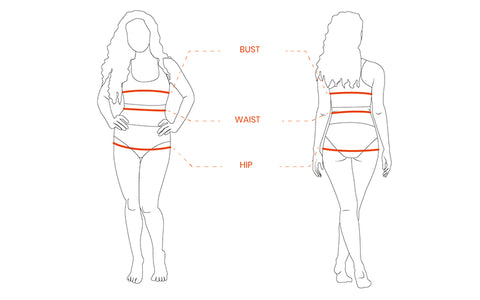MEASURING A BODY
WHAT'S YOUR SIZE?
Don't just assume that our pattern sizes are the same as the sizes of clothing in high street stores. The size charts of clothing brands or other designers may differ slightly among themselves and may also differ from ours. First take your measurements and compare them to our size chart to see what size you need to print.
The first step of your sewing practice is to learn how to measure a body correctly. To find out which standard size of our size chart will fit you best, you will only need to measure 3 areas.
WHERE AND HOW TO MEASURE
Write down your measurements while taking them. You can use the cheat sheet that came with the pattern for this and other important notes.
Bust circumference
Place the measuring tape over the widest part of your bust over your bra. Make sure you hold the tape horizontally.
Waist circumference
Place the tape around the narrowest part of your waist.
Hip circumference
Place the tape around the widest part of your hips, over your underwear. Make sure you hold the tape horizontally.
COMPARE TO OUR SIZE CHART
It's unlikely that your measurements will be exactly the same as the numbers in the size chart. Of course, we're working with human bodies here.
What you do, is: when you're making a top or a dress, you look at the size mentioned next to the bust circumference. When you're making bottom pieces, such as trousers or skirts, then you look at the size next to the hip circumference.
Take the size that has a the number closest to yours. That will be the size you need to print. It's okay if your measurement is a bit more or less, because every garment has some wearing ease. The amount of ease that's been used in the pattern is mentioned in the instructions booklet and on the product page of each pattern (in the finished measurements tab).
For a fitted model, consider adjusting the waist circumference on the pattern to your measured size.
If you are in between sizes, choose the larger size and adjust the pattern as desired. We recommend making a trial version/muslin first, so you can evaluate what and how much needs to be adjusted to fit your needs.
Your height is an important measurement too. In the size chart you can see for which height the patterns were drafted. If you're taller or smaller, correct the length of the patterns accordingly. In the instructions booklet and on the product page of the pattern we've mentioned the finished back length of the garment for your reference.


